Sky High Real Estate: Market Research Report on Households
VerifiedAdded on 2023/01/06
|10
|2440
|96
Report
AI Summary
This report presents market research conducted for Sky High Real Estate, focusing on the evolving structure of Australian households and families. The research investigates the changing preferences of customers regarding housing, analyzing trends in family composition, dwelling structures, and income levels using secondary data from sources like the Australian Bureau of Statistics. The study examines factors such as the rise of nuclear families, the preference for separate houses with multiple bedrooms, and the influence of household income on housing choices. The report provides recommendations for real estate developers to adapt to these trends, suggesting a focus on building houses rather than apartments and conducting regular market surveys to anticipate future fluctuations in household needs and preferences. The analysis highlights the importance of understanding consumer behavior to meet the demands of the Australian housing market effectively.

Market Research
Paraphrase This Document
Need a fresh take? Get an instant paraphrase of this document with our AI Paraphraser
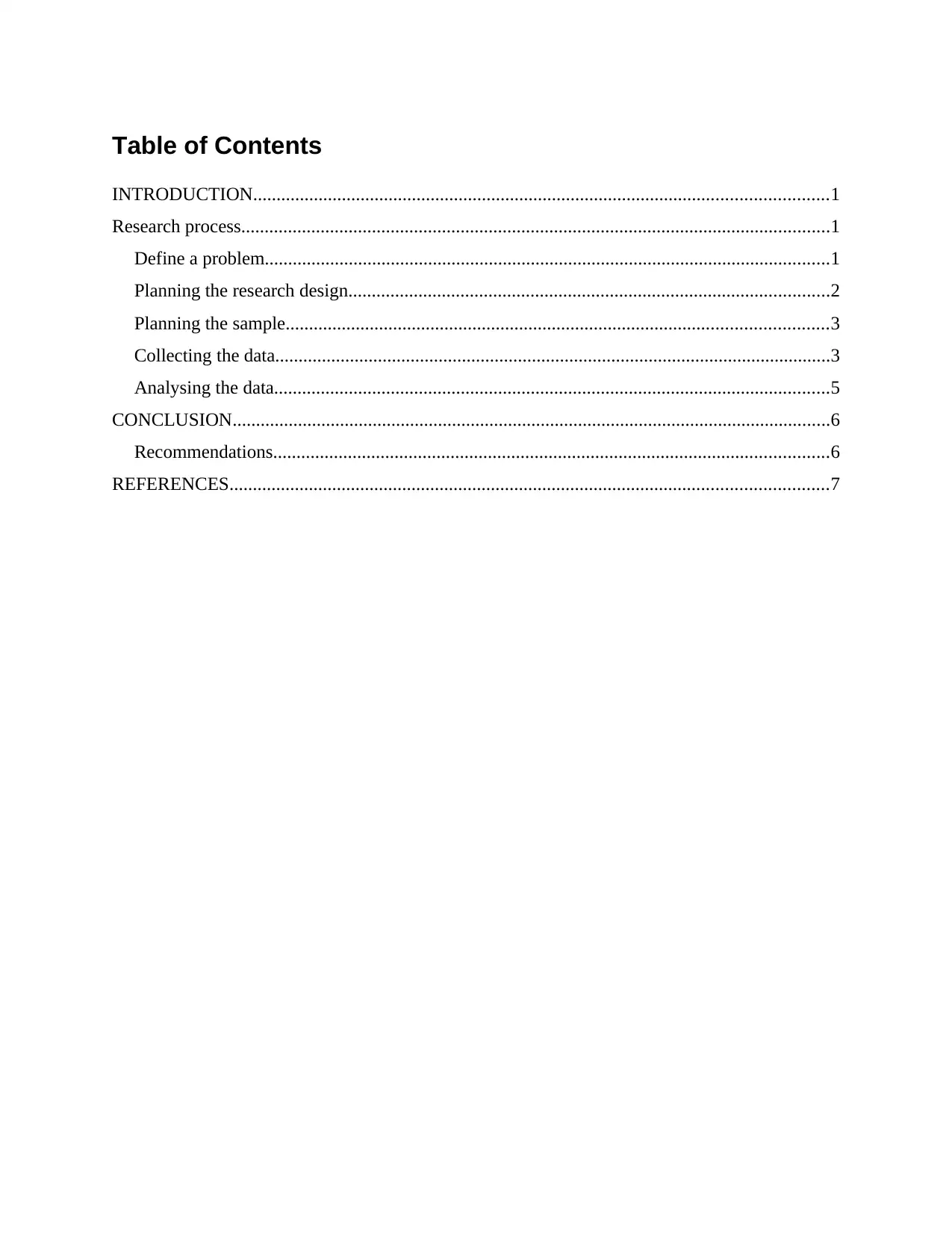
Table of Contents
INTRODUCTION...........................................................................................................................1
Research process..............................................................................................................................1
Define a problem.........................................................................................................................1
Planning the research design.......................................................................................................2
Planning the sample....................................................................................................................3
Collecting the data.......................................................................................................................3
Analysing the data.......................................................................................................................5
CONCLUSION................................................................................................................................6
Recommendations.......................................................................................................................6
REFERENCES................................................................................................................................7
INTRODUCTION...........................................................................................................................1
Research process..............................................................................................................................1
Define a problem.........................................................................................................................1
Planning the research design.......................................................................................................2
Planning the sample....................................................................................................................3
Collecting the data.......................................................................................................................3
Analysing the data.......................................................................................................................5
CONCLUSION................................................................................................................................6
Recommendations.......................................................................................................................6
REFERENCES................................................................................................................................7
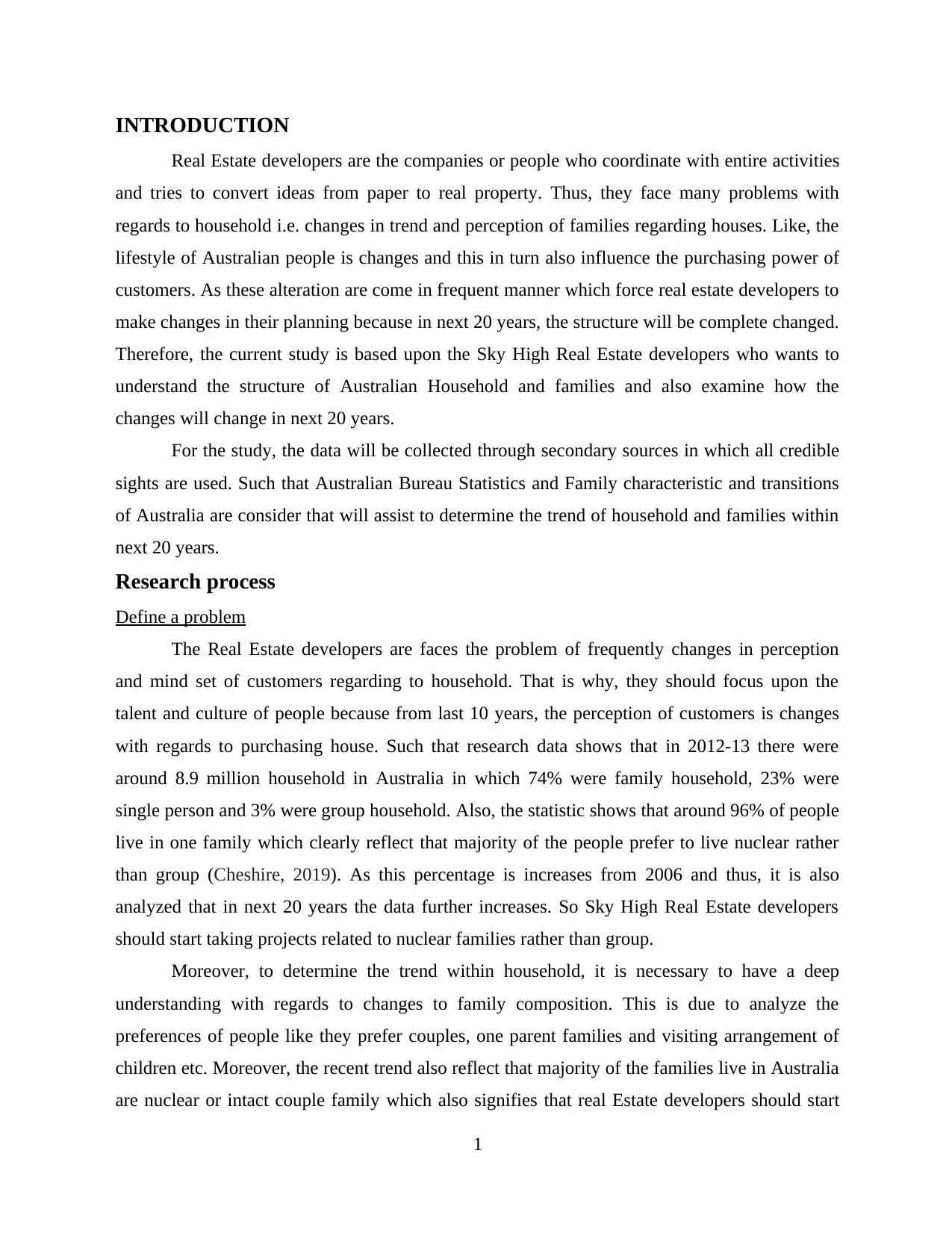
INTRODUCTION
Real Estate developers are the companies or people who coordinate with entire activities
and tries to convert ideas from paper to real property. Thus, they face many problems with
regards to household i.e. changes in trend and perception of families regarding houses. Like, the
lifestyle of Australian people is changes and this in turn also influence the purchasing power of
customers. As these alteration are come in frequent manner which force real estate developers to
make changes in their planning because in next 20 years, the structure will be complete changed.
Therefore, the current study is based upon the Sky High Real Estate developers who wants to
understand the structure of Australian Household and families and also examine how the
changes will change in next 20 years.
For the study, the data will be collected through secondary sources in which all credible
sights are used. Such that Australian Bureau Statistics and Family characteristic and transitions
of Australia are consider that will assist to determine the trend of household and families within
next 20 years.
Research process
Define a problem
The Real Estate developers are faces the problem of frequently changes in perception
and mind set of customers regarding to household. That is why, they should focus upon the
talent and culture of people because from last 10 years, the perception of customers is changes
with regards to purchasing house. Such that research data shows that in 2012-13 there were
around 8.9 million household in Australia in which 74% were family household, 23% were
single person and 3% were group household. Also, the statistic shows that around 96% of people
live in one family which clearly reflect that majority of the people prefer to live nuclear rather
than group (Cheshire, 2019). As this percentage is increases from 2006 and thus, it is also
analyzed that in next 20 years the data further increases. So Sky High Real Estate developers
should start taking projects related to nuclear families rather than group.
Moreover, to determine the trend within household, it is necessary to have a deep
understanding with regards to changes to family composition. This is due to analyze the
preferences of people like they prefer couples, one parent families and visiting arrangement of
children etc. Moreover, the recent trend also reflect that majority of the families live in Australia
are nuclear or intact couple family which also signifies that real Estate developers should start
1
Real Estate developers are the companies or people who coordinate with entire activities
and tries to convert ideas from paper to real property. Thus, they face many problems with
regards to household i.e. changes in trend and perception of families regarding houses. Like, the
lifestyle of Australian people is changes and this in turn also influence the purchasing power of
customers. As these alteration are come in frequent manner which force real estate developers to
make changes in their planning because in next 20 years, the structure will be complete changed.
Therefore, the current study is based upon the Sky High Real Estate developers who wants to
understand the structure of Australian Household and families and also examine how the
changes will change in next 20 years.
For the study, the data will be collected through secondary sources in which all credible
sights are used. Such that Australian Bureau Statistics and Family characteristic and transitions
of Australia are consider that will assist to determine the trend of household and families within
next 20 years.
Research process
Define a problem
The Real Estate developers are faces the problem of frequently changes in perception
and mind set of customers regarding to household. That is why, they should focus upon the
talent and culture of people because from last 10 years, the perception of customers is changes
with regards to purchasing house. Such that research data shows that in 2012-13 there were
around 8.9 million household in Australia in which 74% were family household, 23% were
single person and 3% were group household. Also, the statistic shows that around 96% of people
live in one family which clearly reflect that majority of the people prefer to live nuclear rather
than group (Cheshire, 2019). As this percentage is increases from 2006 and thus, it is also
analyzed that in next 20 years the data further increases. So Sky High Real Estate developers
should start taking projects related to nuclear families rather than group.
Moreover, to determine the trend within household, it is necessary to have a deep
understanding with regards to changes to family composition. This is due to analyze the
preferences of people like they prefer couples, one parent families and visiting arrangement of
children etc. Moreover, the recent trend also reflect that majority of the families live in Australia
are nuclear or intact couple family which also signifies that real Estate developers should start
1
⊘ This is a preview!⊘
Do you want full access?
Subscribe today to unlock all pages.

Trusted by 1+ million students worldwide

invest their time to nuclear family projects because of high number of families are living within
a country (Gilding, 2020). Hence, the frequent change in preference or mind set of people
clearly shows that real estate companies have a deep knowledge regarding this. For that there is
a need to have a strong and deep market research which is completely based upon secondary
data. This in turn leads to examine the family characteristic and transitions which will lead to
portray the picture which will be used in future while dealing with such household projects.
In addition to this, the market research also exhibits that 51% of the people live in couple
families where both parents are employed but there are 869000 dependent children who live in
their lone mother families while 143000 lived in lone father families (Family Characteristic and
transition, 2015). Therefore, this data also signifies that for next 20 years, most of the families
are become nuclear, so developers should start taking such type of project which will become
more beneficial in financial terms.
Planning the research design
In order to solve the problem and determine the trend within household, secondary data
are utilized which in turn leads to meet the define aim. It is so because to identify the solution,
only secondary data sources are used which will help to analyze the trend of living family,
lifestyle and proportion of families living within an area. Moreover, under secondary data
sources specific data are undertaken like Australian Bureau of Statistics and government sites
which provide valid data that assist to analyze the trend for future (Martek and et.al., 2019). In
addition to this, the secondary data are easily available from other sources and also used in
previous research that makes a research more easy. Further it provide up to data information
while primary data do not and even the trend is also analyzed from last 20 years which in turn
assist to analyze the household trend within next years, so that real estate developers may
develop projects accordingly.
On the other side, it is also analyzed that secondary data will provide genuine and valid
information which in turn leads to analyze the results in more better manner. Also, real estate
developers actually face the problem of frequent change in perception of Australian families and
to study the same, it is necessary to understand the past trend. This is possible by examine the
old tendency of people through previous research or government sites that provides reliable data.
On the other side, if primary data sources are used then it is quite difficult to analyze the trend
because small number of sample size is selected which in turn leads does not help to analyze the
2
a country (Gilding, 2020). Hence, the frequent change in preference or mind set of people
clearly shows that real estate companies have a deep knowledge regarding this. For that there is
a need to have a strong and deep market research which is completely based upon secondary
data. This in turn leads to examine the family characteristic and transitions which will lead to
portray the picture which will be used in future while dealing with such household projects.
In addition to this, the market research also exhibits that 51% of the people live in couple
families where both parents are employed but there are 869000 dependent children who live in
their lone mother families while 143000 lived in lone father families (Family Characteristic and
transition, 2015). Therefore, this data also signifies that for next 20 years, most of the families
are become nuclear, so developers should start taking such type of project which will become
more beneficial in financial terms.
Planning the research design
In order to solve the problem and determine the trend within household, secondary data
are utilized which in turn leads to meet the define aim. It is so because to identify the solution,
only secondary data sources are used which will help to analyze the trend of living family,
lifestyle and proportion of families living within an area. Moreover, under secondary data
sources specific data are undertaken like Australian Bureau of Statistics and government sites
which provide valid data that assist to analyze the trend for future (Martek and et.al., 2019). In
addition to this, the secondary data are easily available from other sources and also used in
previous research that makes a research more easy. Further it provide up to data information
while primary data do not and even the trend is also analyzed from last 20 years which in turn
assist to analyze the household trend within next years, so that real estate developers may
develop projects accordingly.
On the other side, it is also analyzed that secondary data will provide genuine and valid
information which in turn leads to analyze the results in more better manner. Also, real estate
developers actually face the problem of frequent change in perception of Australian families and
to study the same, it is necessary to understand the past trend. This is possible by examine the
old tendency of people through previous research or government sites that provides reliable data.
On the other side, if primary data sources are used then it is quite difficult to analyze the trend
because small number of sample size is selected which in turn leads does not help to analyze the
2
Paraphrase This Document
Need a fresh take? Get an instant paraphrase of this document with our AI Paraphraser
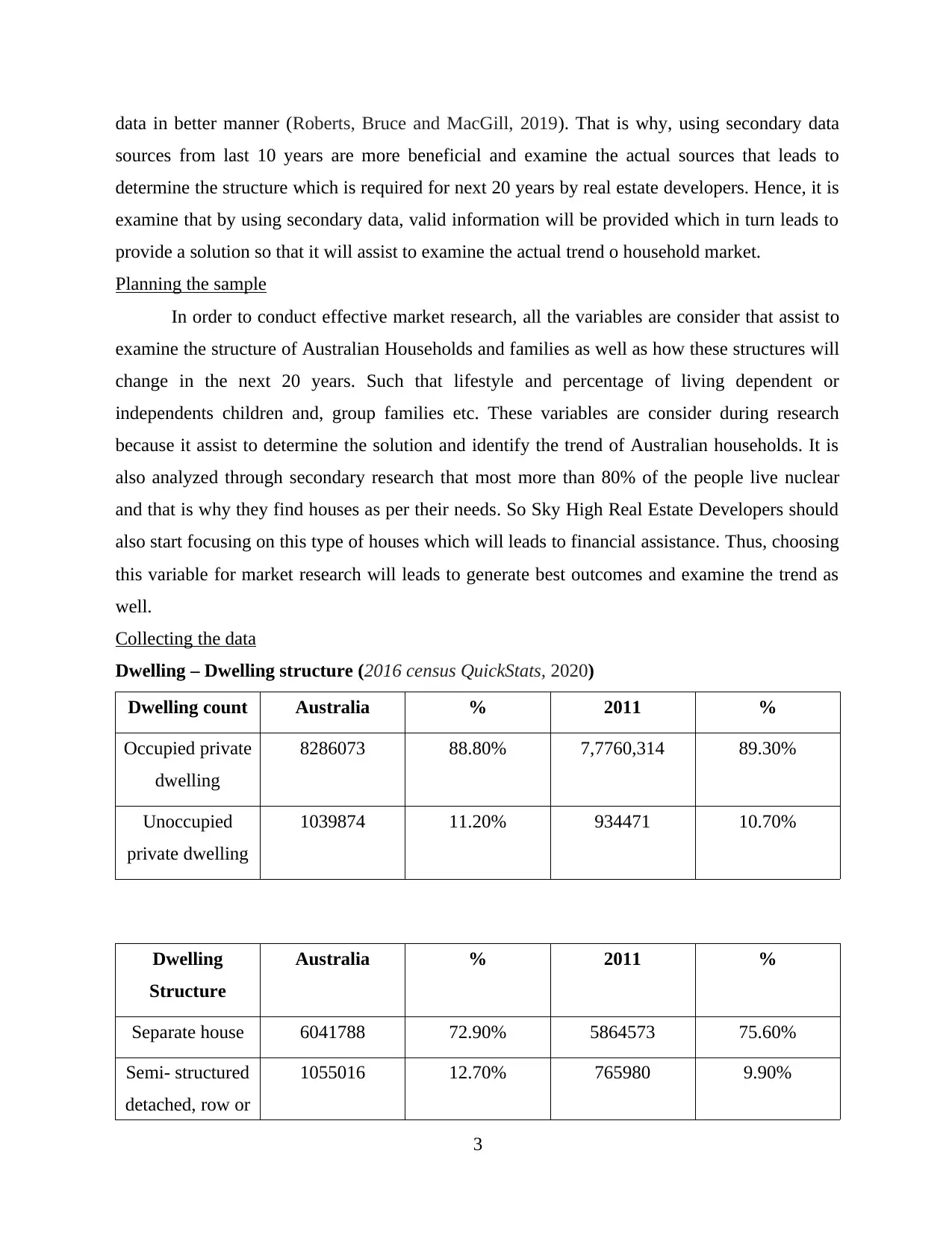
data in better manner (Roberts, Bruce and MacGill, 2019). That is why, using secondary data
sources from last 10 years are more beneficial and examine the actual sources that leads to
determine the structure which is required for next 20 years by real estate developers. Hence, it is
examine that by using secondary data, valid information will be provided which in turn leads to
provide a solution so that it will assist to examine the actual trend o household market.
Planning the sample
In order to conduct effective market research, all the variables are consider that assist to
examine the structure of Australian Households and families as well as how these structures will
change in the next 20 years. Such that lifestyle and percentage of living dependent or
independents children and, group families etc. These variables are consider during research
because it assist to determine the solution and identify the trend of Australian households. It is
also analyzed through secondary research that most more than 80% of the people live nuclear
and that is why they find houses as per their needs. So Sky High Real Estate Developers should
also start focusing on this type of houses which will leads to financial assistance. Thus, choosing
this variable for market research will leads to generate best outcomes and examine the trend as
well.
Collecting the data
Dwelling – Dwelling structure (2016 census QuickStats, 2020)
Dwelling count Australia % 2011 %
Occupied private
dwelling
8286073 88.80% 7,7760,314 89.30%
Unoccupied
private dwelling
1039874 11.20% 934471 10.70%
Dwelling
Structure
Australia % 2011 %
Separate house 6041788 72.90% 5864573 75.60%
Semi- structured
detached, row or
1055016 12.70% 765980 9.90%
3
sources from last 10 years are more beneficial and examine the actual sources that leads to
determine the structure which is required for next 20 years by real estate developers. Hence, it is
examine that by using secondary data, valid information will be provided which in turn leads to
provide a solution so that it will assist to examine the actual trend o household market.
Planning the sample
In order to conduct effective market research, all the variables are consider that assist to
examine the structure of Australian Households and families as well as how these structures will
change in the next 20 years. Such that lifestyle and percentage of living dependent or
independents children and, group families etc. These variables are consider during research
because it assist to determine the solution and identify the trend of Australian households. It is
also analyzed through secondary research that most more than 80% of the people live nuclear
and that is why they find houses as per their needs. So Sky High Real Estate Developers should
also start focusing on this type of houses which will leads to financial assistance. Thus, choosing
this variable for market research will leads to generate best outcomes and examine the trend as
well.
Collecting the data
Dwelling – Dwelling structure (2016 census QuickStats, 2020)
Dwelling count Australia % 2011 %
Occupied private
dwelling
8286073 88.80% 7,7760,314 89.30%
Unoccupied
private dwelling
1039874 11.20% 934471 10.70%
Dwelling
Structure
Australia % 2011 %
Separate house 6041788 72.90% 5864573 75.60%
Semi- structured
detached, row or
1055016 12.70% 765980 9.90%
3
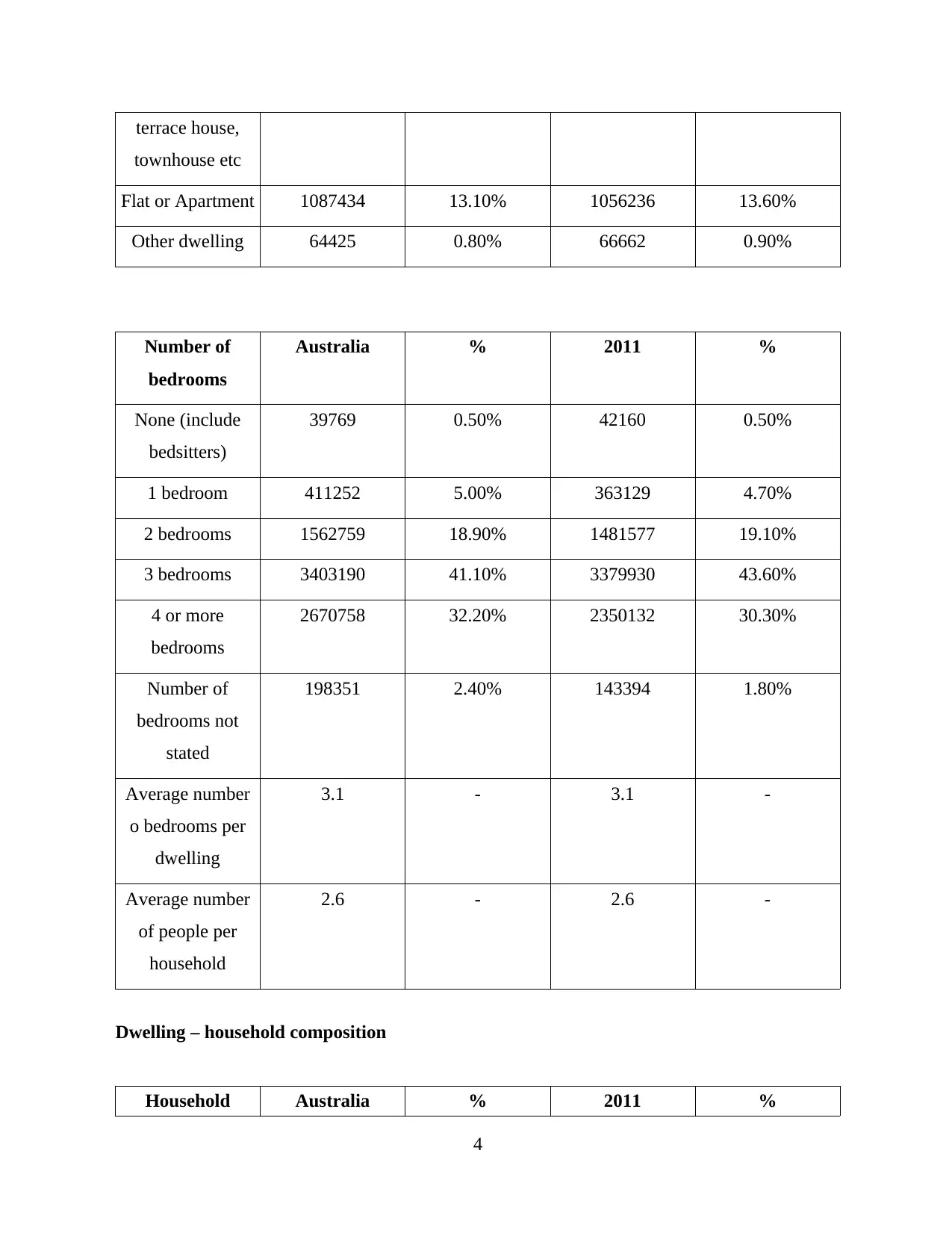
terrace house,
townhouse etc
Flat or Apartment 1087434 13.10% 1056236 13.60%
Other dwelling 64425 0.80% 66662 0.90%
Number of
bedrooms
Australia % 2011 %
None (include
bedsitters)
39769 0.50% 42160 0.50%
1 bedroom 411252 5.00% 363129 4.70%
2 bedrooms 1562759 18.90% 1481577 19.10%
3 bedrooms 3403190 41.10% 3379930 43.60%
4 or more
bedrooms
2670758 32.20% 2350132 30.30%
Number of
bedrooms not
stated
198351 2.40% 143394 1.80%
Average number
o bedrooms per
dwelling
3.1 - 3.1 -
Average number
of people per
household
2.6 - 2.6 -
Dwelling – household composition
Household Australia % 2011 %
4
townhouse etc
Flat or Apartment 1087434 13.10% 1056236 13.60%
Other dwelling 64425 0.80% 66662 0.90%
Number of
bedrooms
Australia % 2011 %
None (include
bedsitters)
39769 0.50% 42160 0.50%
1 bedroom 411252 5.00% 363129 4.70%
2 bedrooms 1562759 18.90% 1481577 19.10%
3 bedrooms 3403190 41.10% 3379930 43.60%
4 or more
bedrooms
2670758 32.20% 2350132 30.30%
Number of
bedrooms not
stated
198351 2.40% 143394 1.80%
Average number
o bedrooms per
dwelling
3.1 - 3.1 -
Average number
of people per
household
2.6 - 2.6 -
Dwelling – household composition
Household Australia % 2011 %
4
⊘ This is a preview!⊘
Do you want full access?
Subscribe today to unlock all pages.

Trusted by 1+ million students worldwide

composition
Family household 5907625 71.30% 550611 71.50%
Single or lone
person household
2023542 24.40% 1888697 24.30%
Group household 354917 4.30% 321005 4.10%
Household
income
Australia % 2011 %
Less than $650
gross weekly
income
- 20.00% - 23.70%
More than $3000
gross weekly
income
- 16.40% - 11.20%
Analysing the data
From the data collected through Australian Bureau of Statistic, it is analyzed that
majority of the Australian people prefer to have their own private houses as compared to rent.
Such that the data shows around 88.8% people prefer to occupied private dwelling in which
72.9% of the people wants their separate house. On the other side, there is only 13.1% of people
who wants flats and apartment. Therefore, it is clearly analyzed that these Australian people
mostly prefer to have 3 to 4 bedrooms as compared to 1 because secondary data clearly shows
that 41.1% of the people wants 3 bedrooms in their house while 5% of them stated that they
prefer 1 bedroom which is prefer to lone person.
On the other side, while dealing with future projects, real estate developers should
consider the income of people so that it do not affect the preference of people. As the data
signifies that the income of household people is only $650 and that is why, estate developers
should invest the same so that in return they get future benefits (Zyed, Abd Aziz and Hanif,
5
Family household 5907625 71.30% 550611 71.50%
Single or lone
person household
2023542 24.40% 1888697 24.30%
Group household 354917 4.30% 321005 4.10%
Household
income
Australia % 2011 %
Less than $650
gross weekly
income
- 20.00% - 23.70%
More than $3000
gross weekly
income
- 16.40% - 11.20%
Analysing the data
From the data collected through Australian Bureau of Statistic, it is analyzed that
majority of the Australian people prefer to have their own private houses as compared to rent.
Such that the data shows around 88.8% people prefer to occupied private dwelling in which
72.9% of the people wants their separate house. On the other side, there is only 13.1% of people
who wants flats and apartment. Therefore, it is clearly analyzed that these Australian people
mostly prefer to have 3 to 4 bedrooms as compared to 1 because secondary data clearly shows
that 41.1% of the people wants 3 bedrooms in their house while 5% of them stated that they
prefer 1 bedroom which is prefer to lone person.
On the other side, while dealing with future projects, real estate developers should
consider the income of people so that it do not affect the preference of people. As the data
signifies that the income of household people is only $650 and that is why, estate developers
should invest the same so that in return they get future benefits (Zyed, Abd Aziz and Hanif,
5
Paraphrase This Document
Need a fresh take? Get an instant paraphrase of this document with our AI Paraphraser
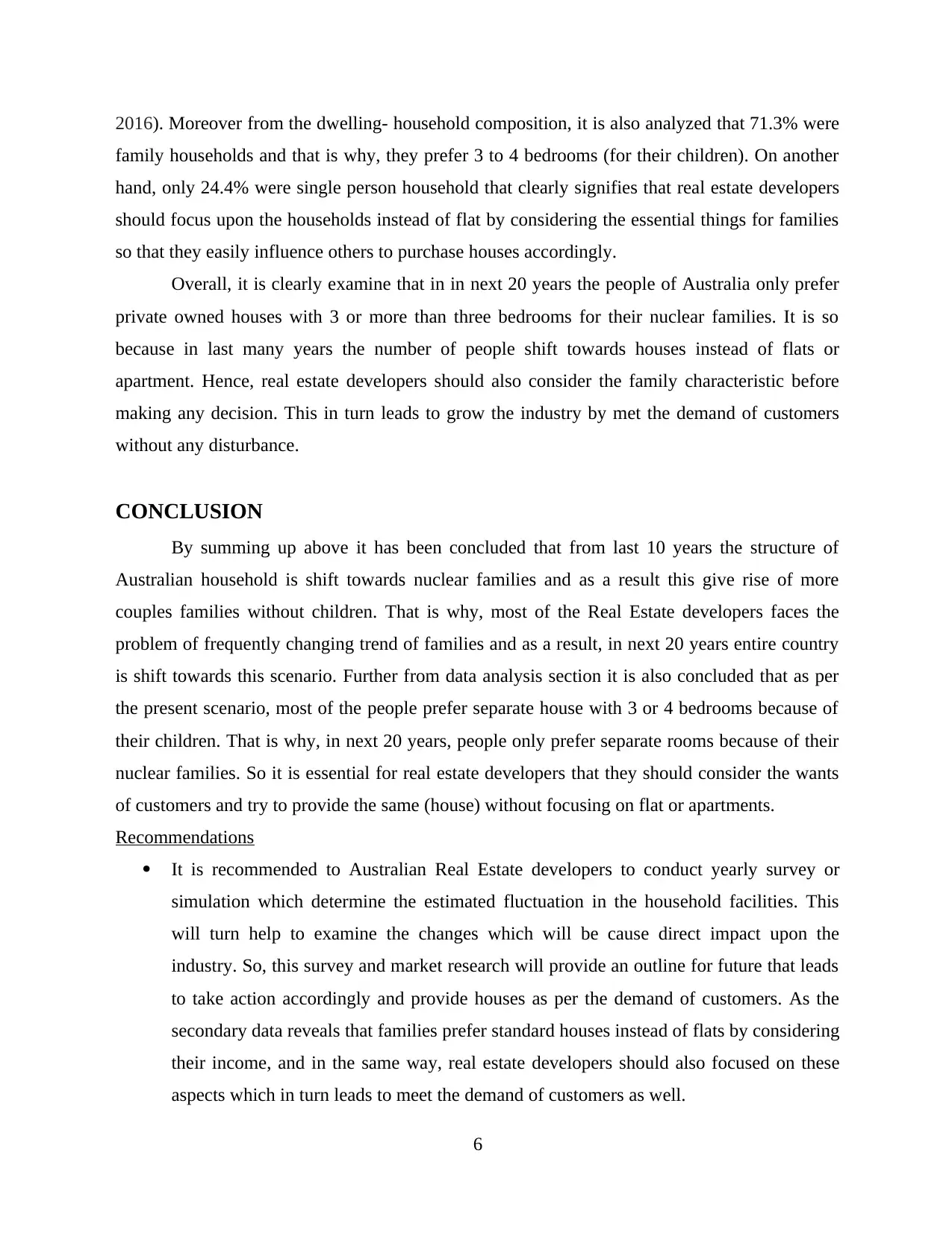
2016). Moreover from the dwelling- household composition, it is also analyzed that 71.3% were
family households and that is why, they prefer 3 to 4 bedrooms (for their children). On another
hand, only 24.4% were single person household that clearly signifies that real estate developers
should focus upon the households instead of flat by considering the essential things for families
so that they easily influence others to purchase houses accordingly.
Overall, it is clearly examine that in in next 20 years the people of Australia only prefer
private owned houses with 3 or more than three bedrooms for their nuclear families. It is so
because in last many years the number of people shift towards houses instead of flats or
apartment. Hence, real estate developers should also consider the family characteristic before
making any decision. This in turn leads to grow the industry by met the demand of customers
without any disturbance.
CONCLUSION
By summing up above it has been concluded that from last 10 years the structure of
Australian household is shift towards nuclear families and as a result this give rise of more
couples families without children. That is why, most of the Real Estate developers faces the
problem of frequently changing trend of families and as a result, in next 20 years entire country
is shift towards this scenario. Further from data analysis section it is also concluded that as per
the present scenario, most of the people prefer separate house with 3 or 4 bedrooms because of
their children. That is why, in next 20 years, people only prefer separate rooms because of their
nuclear families. So it is essential for real estate developers that they should consider the wants
of customers and try to provide the same (house) without focusing on flat or apartments.
Recommendations
It is recommended to Australian Real Estate developers to conduct yearly survey or
simulation which determine the estimated fluctuation in the household facilities. This
will turn help to examine the changes which will be cause direct impact upon the
industry. So, this survey and market research will provide an outline for future that leads
to take action accordingly and provide houses as per the demand of customers. As the
secondary data reveals that families prefer standard houses instead of flats by considering
their income, and in the same way, real estate developers should also focused on these
aspects which in turn leads to meet the demand of customers as well.
6
family households and that is why, they prefer 3 to 4 bedrooms (for their children). On another
hand, only 24.4% were single person household that clearly signifies that real estate developers
should focus upon the households instead of flat by considering the essential things for families
so that they easily influence others to purchase houses accordingly.
Overall, it is clearly examine that in in next 20 years the people of Australia only prefer
private owned houses with 3 or more than three bedrooms for their nuclear families. It is so
because in last many years the number of people shift towards houses instead of flats or
apartment. Hence, real estate developers should also consider the family characteristic before
making any decision. This in turn leads to grow the industry by met the demand of customers
without any disturbance.
CONCLUSION
By summing up above it has been concluded that from last 10 years the structure of
Australian household is shift towards nuclear families and as a result this give rise of more
couples families without children. That is why, most of the Real Estate developers faces the
problem of frequently changing trend of families and as a result, in next 20 years entire country
is shift towards this scenario. Further from data analysis section it is also concluded that as per
the present scenario, most of the people prefer separate house with 3 or 4 bedrooms because of
their children. That is why, in next 20 years, people only prefer separate rooms because of their
nuclear families. So it is essential for real estate developers that they should consider the wants
of customers and try to provide the same (house) without focusing on flat or apartments.
Recommendations
It is recommended to Australian Real Estate developers to conduct yearly survey or
simulation which determine the estimated fluctuation in the household facilities. This
will turn help to examine the changes which will be cause direct impact upon the
industry. So, this survey and market research will provide an outline for future that leads
to take action accordingly and provide houses as per the demand of customers. As the
secondary data reveals that families prefer standard houses instead of flats by considering
their income, and in the same way, real estate developers should also focused on these
aspects which in turn leads to meet the demand of customers as well.
6
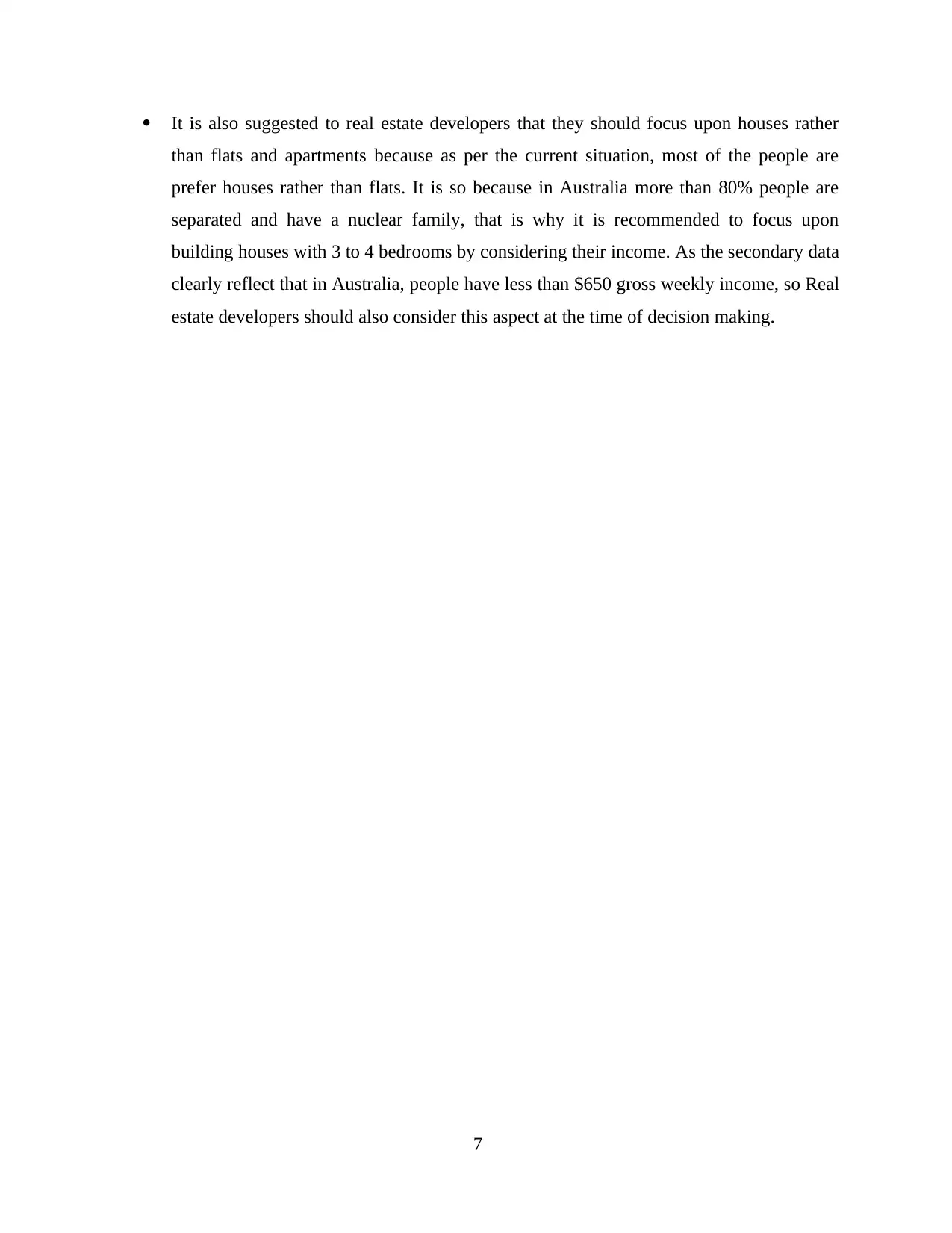
It is also suggested to real estate developers that they should focus upon houses rather
than flats and apartments because as per the current situation, most of the people are
prefer houses rather than flats. It is so because in Australia more than 80% people are
separated and have a nuclear family, that is why it is recommended to focus upon
building houses with 3 to 4 bedrooms by considering their income. As the secondary data
clearly reflect that in Australia, people have less than $650 gross weekly income, so Real
estate developers should also consider this aspect at the time of decision making.
7
than flats and apartments because as per the current situation, most of the people are
prefer houses rather than flats. It is so because in Australia more than 80% people are
separated and have a nuclear family, that is why it is recommended to focus upon
building houses with 3 to 4 bedrooms by considering their income. As the secondary data
clearly reflect that in Australia, people have less than $650 gross weekly income, so Real
estate developers should also consider this aspect at the time of decision making.
7
⊘ This is a preview!⊘
Do you want full access?
Subscribe today to unlock all pages.

Trusted by 1+ million students worldwide

REFERENCES
Books and Journals
Cheshire, L., 2019. The limits to authority: Developer interventions and neighbour problems on
a master planned estate. Housing, Theory and Society.36(1). pp.92-111.
Gilding, M., 2020. The making and breaking of the Australian family. Routledge.
Martek, I. and et.al., 2019. Barriers inhibiting the transition to sustainability within the
Australian construction industry: An investigation of technical and social
interactions. Journal of cleaner production. 211. pp.281-292.
Roberts, M.B., Bruce, A. and MacGill, I., 2019. Opportunities and barriers for photovoltaics on
multi-unit residential buildings: Reviewing the Australian experience. Renewable and
Sustainable Energy Reviews.104. pp.95-110.
Zyed, Z.A.S., Abd Aziz, W.N.A.W. and Hanif, N.R., 2016. Housing affordability problems
among young households. Journal of Surveying, Construction and Property.7(1). pp.1-
18.
Online
2016 census QuickStats. 2020. [Online]. Available through:
<https://quickstats.censusdata.abs.gov.au/census_services/getproduct/census/2016/
quickstat/036>.
Family Characteristic and transition. 2015. Online]. Available through:
<https://www.abs.gov.au/statistics/people/people-and-communities/family-
characteristics-and-transitions/latest-release>.
8
Books and Journals
Cheshire, L., 2019. The limits to authority: Developer interventions and neighbour problems on
a master planned estate. Housing, Theory and Society.36(1). pp.92-111.
Gilding, M., 2020. The making and breaking of the Australian family. Routledge.
Martek, I. and et.al., 2019. Barriers inhibiting the transition to sustainability within the
Australian construction industry: An investigation of technical and social
interactions. Journal of cleaner production. 211. pp.281-292.
Roberts, M.B., Bruce, A. and MacGill, I., 2019. Opportunities and barriers for photovoltaics on
multi-unit residential buildings: Reviewing the Australian experience. Renewable and
Sustainable Energy Reviews.104. pp.95-110.
Zyed, Z.A.S., Abd Aziz, W.N.A.W. and Hanif, N.R., 2016. Housing affordability problems
among young households. Journal of Surveying, Construction and Property.7(1). pp.1-
18.
Online
2016 census QuickStats. 2020. [Online]. Available through:
<https://quickstats.censusdata.abs.gov.au/census_services/getproduct/census/2016/
quickstat/036>.
Family Characteristic and transition. 2015. Online]. Available through:
<https://www.abs.gov.au/statistics/people/people-and-communities/family-
characteristics-and-transitions/latest-release>.
8
1 out of 10
Related Documents
Your All-in-One AI-Powered Toolkit for Academic Success.
+13062052269
info@desklib.com
Available 24*7 on WhatsApp / Email
![[object Object]](/_next/static/media/star-bottom.7253800d.svg)
Unlock your academic potential
Copyright © 2020–2025 A2Z Services. All Rights Reserved. Developed and managed by ZUCOL.





